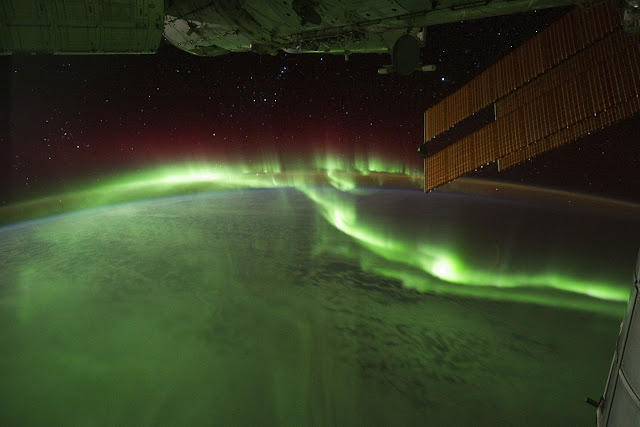Astronauts on the International Space Station (ISS) used a digital camera to capture several hundred photographs of the aurora australis, or “southern lights,” while passing over the Indian Ocean on September 17, 2011. If you click on the movie linked above, you can see the flowing ribbons and rays below as the ISS passed from south of Madagascar to just north of Australia between 17:22 and 17:45 Universal Time. Solar panels and other sections of the ISS fill some of the upper right side of the photograph.
Auroras are a spectacular sign that our planet is electrically and magnetically connected to the Sun. These light shows are provoked by energy from the Sun and fueled by electrically charged particles trapped in Earth’s magnetic field, or magnetosphere. In this case, the space around Earth was stirred up by an explosion of hot, ionized gas from the Sun—a coronal mass ejection—that left the Sun on September 14, 2011.
The pressure and magnetic energy of the solar plasma stretches and twists the magnetic field of Earth like rubber bands, particularly in the tail on the night side. This energizes the particles trapped in our magnetic field; that energy is released suddenly as the field lines snap the particles down the field lines toward the north and south magnetic poles.
Fast-moving electrons collide with Earth’s upper atmosphere, transferring their energy to oxygen and nitrogen molecules and making them chemically “excited.” As the gases return to their normal state, they emit photons, small bursts of energy in the form of light. The color of light reflects the type of molecules releasing it; oxygen molecules and atoms tend to glow green, white or red, while nitrogen tends to be blue or purple. This ghostly light originates at altitudes of 100 to 400 kilometers (60 to 250 miles).
Image Credit: NASA
Explanation from: http://earthobservatory.nasa.gov/IOTD/view.php?id=52287




awesome1
ReplyDeleteTrès beau bravo station internationale
ReplyDelete